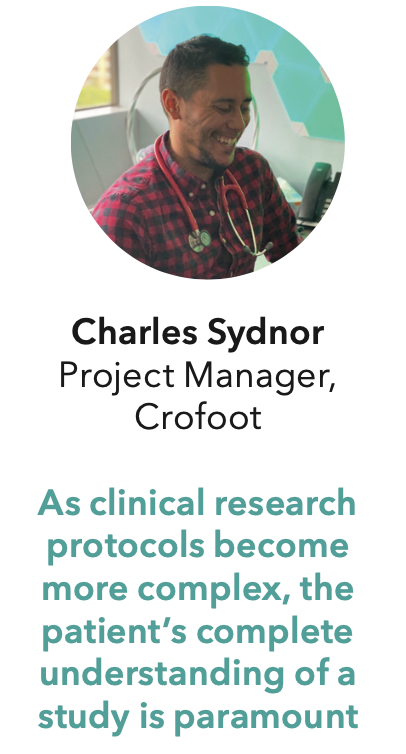Shifting from Paper to Digital Patient Consent
Charles Sydnor, CCRA, ACRP-CP, project manager at Crofoot, discusses how offering a digital patient experience in trials enables the site to provide better patient care.

Clinical research sites are modernizing trial operations with site-centric applications to provide a digital patient experience. Crofoot Research Center, a Houston-based practice that has run over 200 clinical studies in rare disease, is one site realizing the benefits of using patient-centric, site-first solutions.
With an eRegulatory system and eConsent from Veeva Systems, Crofoot is shifting from manual and paper-based processes to more streamlined, digital execution. Charles Sydnor, CCRA, ACRP-CP, project manager at Crofoot, discussed how offering a digital patient experience in trials enables the site to provide better patient care.
Applied Clinical Trials: What challenges did Crofoot experience with traditional, paper-based informed consent?
Charles Sydnor: Patient reach and accessibility have always been our biggest barriers in studies. COVID-19 made reaching new patients even harder, as most could not physically come into our practice. Using paper-based consenting wasn’t a feasible option because of the travel, distance, and safety concerns, impacting our reach and preventing many patients from considering research as a treatment option.
Over the years, we have seen how paper complicates execution, reduces efficiency, and provides limited accountability. Using paper, paying for storage, and hiring additional staff to manually check all the consent forms for completion, errors, and appropriate signatures dramatically increased our economic burden.
Lastly, we want to ensure that the potential participant understands the study, especially the risks and benefits. The traditional paper-based model of consenting does not lend to better participant comprehension but rather the exact opposite. Handing a 20-plus page consent document is an intimidating and overwhelming event, and many participants complain that the font can be too small for review.
ACT: How has paper-based consent impacted the patient experience?
Sydnor: Ideally, we’d want to give patients as much time as possible to consider participation, ask questions, and talk to their support system at home before choosing a trial. But once a patient travels into our practice, they usually feel pressure to make a quick decision to avoid another visit. That pressure takes a toll on patients who want to consult family members before deciding to participate in a study, leading to early opt-outs.
Patients also have to come in for a screening, often not scheduled on the same day as consenting. An appointment to provide consent could be in several days or several weeks, but it almost always ends up in another visit for the patient. Thus, paper consent increases the patient burden of participating in trials, requiring more time and travel.
ACT: How has Crofoot’s shift to digital improved the patient experience?
Sydnor: Since we already had an eRegulatory system in place, it made sense to bring in an eConsent solution that enables seamless exchange of information. Implementing eConsent has given patients the flexibility to review documents on their own time and wherever they feel most comfortable.
As clinical research protocols become more complex, the patient’s complete understanding of a study is paramount. Using eConsent allows us to format study information in a more digestible form. This ensures that each participant fully understands what they are signing up for. It is important to remember that each person has different needs, and removing paper will optimize the patients’ experience.
We’ve noticed a significant improvement in patient understanding of studies with eConsent. Numerous patients have expressed gratitude for the ease at which they can access documents, allowing review with those closest to them.
ACT: What improvements has your research center achieved by using eConsent?
Sydnor: Our mission is to reflect the diversity of Houston. But patient reach has been the most significant barrier for us to overcome. This makes our efforts to digitize consent even more critical. eConsent has helped us gain access to individuals in rural areas and underserved communities that may not have access to healthcare.
eConsent allows us to provide patients with more flexibility and minimizes travel. Patients appreciate this, as we’ve seen an increase in recruitment numbers and participant diversity.
Using a digital consenting solution that can exchange information with our investigator site file (ISF) has removed many of the hurdles we experienced for years with paper filing and maintaining ICF logs. As a result, our team is now better prepared to review documents, ensure accuracy, and seamlessly file a patient’s information.
In addition, audits are now handled more efficiently. Our digital solutions allow sponsors and CROs to quickly validate information and ensure all our activity is compliant. Having the ability to share documents across our systems and with our partners has allowed us to work more systematically and cost effectively.
For research sites thinking that the cost of technology is a barrier to adoption, this isn’t always the case. For us, as a small private practice without a large budget, eConsent presented a very achievable point of entry. We have significantly reduced our administrative workload and expenses on storage, printing, and tangible goods. Using a digital consenting solution has improved productivity, enhanced the patient experience, and increased our site’s ability to handle larger workloads.
ACT: You’ve now implemented an eRegulatory system and eConsent, two solutions transforming how research sites work. What advice would you give a site considering new technology?
Sydnor: The thought of implementing new technology was scary for me at first. But digging in and investing the time has paid off. My advice to sites exploring new solutions would be to commit and follow-through, from evaluation to deployment. Bringing in technology takes a lot of work upfront and is a cross-team effort, but in the end, the benefits for your research site can be transformational. That level of change and improvement to site operations allows you to spend more time where it makes an impact: with patients.













